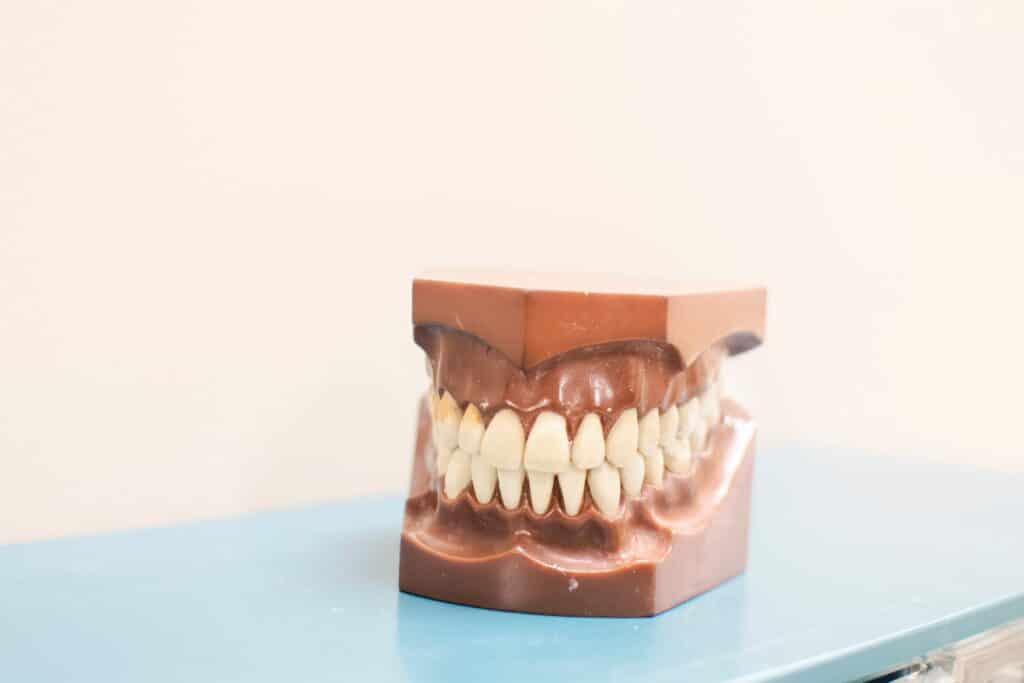Dr. Rod says: I prefer using fluoride in my practice to desensitize the dentin. I try to stay away from the stannous fluorides because of the metallic taste. Compliance usually becomes an issue and patients just quit using it at some point. Recently I began to prescribe products such as MI paste ® (GC America) and 3M’s Clinpro 5000®, which contains sodium fluoride. Both these products possess regenerative capability. They taste good so compliance is improved.
My dental hygienist gave no credence to the New York Times article about flossing. She always “leans on” her patients to encourage them to floss EVERY day. When I see the link between periodontitis and Alzheimer’s, it makes me want to never skip flossing!!
Table of Contents
According to the CDC:
More than 1 in 4 (26%) adults in the United States have untreated tooth decay. Adults who are low-income, have less than a high school education, non-Hispanic Black, and current smokers are 2 times more likely to have untreated cavities than comparison groups.
Nearly half (46%) of all adults aged 30 years or older show signs of gum disease; severe gum disease affects about 9% of adults. Dental needs are great, and with the Medicaid reimbursements being so low, many patients struggle to find a dentist who will accept these payments. We frequently counsel patients with dental issues and see patients treated in the Emergency Department for dental pain.
Treatment of Sensitive Teeth and Dental Floss
Sensitive teeth, or dentin hypersensitivity, occurs when a stimulus is applied to the tooth. Some types of stimuli can be physical, like temperature, or chemical.
Dentin, the layer of the teeth beneath the enamel, becomes exposed by gingival recession or enamel loss. Enamel is the hardest surface in our body and consists of 96% hydroxyapatite, which is a combination calcium and phosphate. The bones and dentin in our body are comprised of 70% hydroxyapatite. Dentin hypersensitivity is found most commonly in patients with loss of tooth enamel. Other common instances for hypersensitivity are when dentin has become exposed due to gingival recession and in a patients who have undergone periodontal therapy.
Dentin contains tubules, which are open pathways between the dentin-enamel junction and pulp, the jelly-like center, of our teeth. Stimulus causes an increase in fluid flow through tubule, causing pain at the pulp and its nerves. As we discussed, tooth abrasion from brushing and toothpaste selection can contribute to the wear and tear on the enamel because it exposes the dentin and allows for pain transmission through the tubules. During professional whitening treatments, 55-75% of patients may experience tooth sensitivity.
TREATMENT:
- The most important step in treating dentin sensitivity is to STOP destructive habits such as aggressive or vigorous cross brushing.
- Excessive amount of toothpaste may cause abrasion.
- Review the “Modified Bass Brushing Technique”
- As a lot of dental professionals say, “It is not the brush; it is the brusher!”
- Use soft-bristle toothbrushes.
- Consult your dentist, dental hygienist, or pharmacist to recommend a toothpaste with a lower Relative Dentin Abrasivity (RDA.)
- Recommend twice-daily use of a desensitizing dentifrice.
- Active ingredients include stannous fluoride, strontium chloride hexahydrate, aluminum or potassium ferric oxalates, and fluorides.
- Studies show improvement in patients’ pain perception with dentifrice use, and that product effectiveness to decrease symptoms appears with increased use of the product. Patients will experience more benefit the longer they use these products.
- Fluoride dental paste: (Prevident-5000 Plus®) written as a prescription, works by forming the precipitate calcium fluoride which plugs the tubules. Fluoride is an effective agent to control dentin hypersensitivity and to prevent root caries particularly when used in higher concentrations.
- Remind patients to brush on this dentifrice, but do not swallow.
- Patients should spit out the medication, but do not eat, drink, or rinse for 30 minutes after use.
- Prevident® 5000 Sensitive Teeth ® contains 5% potassium nitrate along with the Sodium Fluoride 1.1% (which is 4 times stronger than OTC toothpaste).
- Potassium nitrate (KNO3) 5%: Alters membrane potential along the dentin nerves. After passing through dentinal tubules, it helps occlude the exposed dentinal tubules and decreases flow. Potassium nitrate lowers nerve sensitivity by blocking the synapse between nerve cells, reducing nerve excitation and the associated pain.
- Strontium chloride hexahydrate 10%: Reduces the discomfort and pain caused by thermal and tactile stimuli in patients with dentinal hypersensitivity. Strontium works by exchanging calcium for strontium in biological processes. Strontium also impairs nerve stimulation by changing stimulus transmission. These treatments reduce flow into the dentin tubules by occluding or sclerosing the tubules.
Note: If there is no relief after brushing twice daily for 2 or 3 weeks, a visit to the dentist is recommended.
DENTAL FLOSS
We all have that spool of “nylon yarn” in our bathrooms. Some of us use it a lot more than others. Dental floss was formerly made of silk, but is presently made of nylon filaments or single strand plastic monofilaments. Flossing helps remove plaque by reaching areas that a brush cannot reach. By removing debris from these hard-to-reach tooth surfaces we may see a reduction in the likelihood of gum disease and tooth decay. Look for the American Dental Association Seal of Approval before purchasing dental floss.
To earn the ADA Seal of Approval…
- Flossing + tooth brushing is more effective than brushing alone at reducing plaque and gingivitis. Assessments must occur at baseline and 30 days to prove efficacy.
- The product components are safe for use in the mouth.
- Unsupervised use of the product by the average patient will not harm hard or soft oral tissues or restorations
- Tensile strength: high tenacity “nylon yarn” is best because:
- Abrasion resistance of nylon occurs drawn over rough surfaces.
- Elasticity of nylon is greater, allowing it to pass through close places and over rough surfaces with less filament breakage.
- Both Reach® (J&J) and Oral-B ® dental floss are ADA approved
What floss should I buy:
Simply stated it is the patient’s choice based on preference (ex. waxed or unwaxed, flavored or not flavored)
- Large gaps between teeth: Try dental tape or Super Floss ®, or JJ Reach® woven floss.
- Tight spaces: recommend a waxed floss or Oral-B Glide®
- Less mess: disposable flossers or floss in pre-measured strands
- Braces or bridges: A spongy floss is preferred
- However, any floss is OK with dental appliances
- Floss threader may be beneficial as well
Is Flossing Worth the Effort? Flossing Controversy: August 2, 2016- New York Times
“There is some evidence from twelve studies that flossing in addition to toothbrushing reduces gingivitis compared to toothbrushing alone. There is weak, very unreliable evidence from 10 studies that flossing plus toothbrushing may be associated with a small reduction in plaque at 1 and 3 months. No studies reported the effectiveness of flossing plus toothbrushing for preventing dental caries.”
- ADA response: In this case, while the average benefit is small and the quality of the evidence is very low (meaning the true average benefit could be higher or lower), given that periodontal disease is estimated to affect half of all Americans, even a small benefit may be helpful. The other side of the benefit-risk analysis is an absence of documented harm and minimal cost to patients.
- The Association also released a statement in response to the news story, reiterating its recommendations to maintain oral health, which include “brushing for two minutes, twice a day with a fluoride toothpaste, cleaning between teeth once a day with an interdental cleaner and regular dental visit advised by your dentist.” The ADA also stated that interdental cleaners, including floss, “are an essential part of taking care of your teeth and gums.”
- There is reliable data correlating periodontal disease and heart disease. I have yet to find a dentist that has told their patients there is no need to floss. Keep flossing… even when you are not eating corn-on the cob!
- Periodontitis- Alzheimer’s link? Porphyromonas gingivalis is a key player in periodontal disease. During normal activities like chewing or toothbrushing, the bacteria can be easily introduced to the bloodstream. Toxic proteases from the bacterium called gingipains were also identified in the brain of Alzheimer’s patients, and levels correlated with tau and ubiquitin pathology. A study published in 2020 by The Journal of Alzheimer’s Disease Reports states that P.gingivalis DNA was found in the saliva and cerebrospinal fluid of individuals with Alzheimer’s disease. (https://pubmed.ncbi.nlm.nih.gov/30746447/)
How To Treat sensitive Teeth & Dental Floss
Are you a pharmacist or pharmacy technician looking for fun and engaging CE opportunities? freeCE is the #1 online CE platform for pharmacy professionals who are looking for accredited CE’s and instant reporting. View our Live CE calendar or sign up for one of our unlimited CE options.






